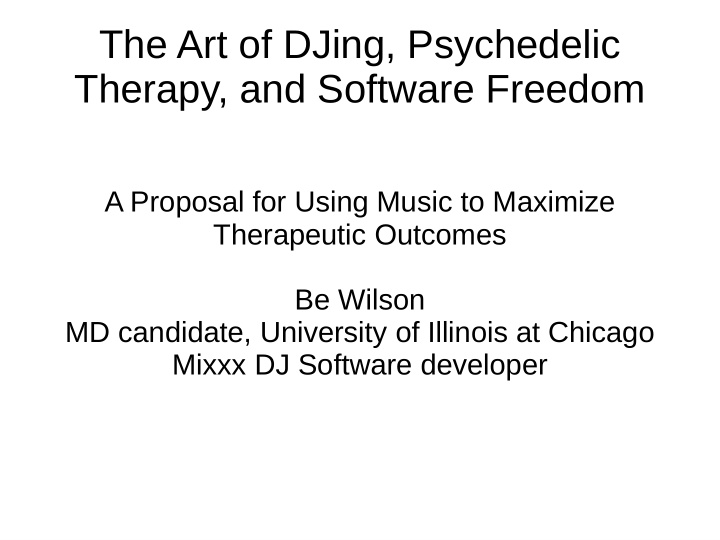



The Art of DJing, Psychedelic Therapy, and Software Freedom A Proposal for Using Music to Maximize Therapeutic Outcomes Be Wilson MD candidate, University of Illinois at Chicago Mixxx DJ Software developer
Introduction ● Feel free to ask questions during presentation. ● Please record this. ● This is not the only way, just one way that makes sense to me. ● Raise your hand if you: – Love music – Listen to music on a regular basis – Have a music collection (not streaming) – Have ever DJed – Are a clinician/in training/want to become a clinician who uses psychedelic medicines in therapy
Music & Psychedelics ● Indigenous ceremonies – Ayahuasca icaros – Peyote songs ● Scientific research – Mid 20 th century (Hoffer 1965, Bonny & Pahnke 1972) – Contemporary ● Popular culture
Why play music? ● Intensify emotions ● Facilitate peak/mystical experiences ● Guidance ● Support ● Movement ● “Patients’ experience of the music, but not drug intensity, was predictive of reductions in depression 1 week later, suggesting that music plays a central mediating role in psychedelic therapy.” (Kaelen 2018)
How to select music? ● Follow course of psychedelic experience (Bonny & Pahnke 1972, Grof 1980) – pre-onset, onset, building towards peak, peak, re-entry, return ● Music’s resonance with patient’s emotional state significantly correlated with reduction in depression (Kaelen 2018) ● Predetermined playlist – Consistency helps for scientific research – Easy, requires minimal attention by therapists during session – May not resonate with a particular patient or situation – Requires lots of preparation time
Selecting music in the moment ● Allows therapists to adapt music to maximize resonance with patient’s experience ● This is the art of DJing ● … so let’s use equipment made for DJing
DJ software ● Modeled after 2 turntables + DJ mixer ● Plays > 1 track at a time ● Headphone output for previewing music – Decide whether next track is appropriate
Mixxx
Album DJing ● DJ software is designed for picking one track after the other – Requires continual focus – Detracts from being present with patient ● Play entire albums at a time instead of individual tracks ● Respond to present moment without getting distracted by picking music ● DJ software is not designed for this, but allows previewing in headphones
Redesigning Mixxx
Software Freedom ● Mixxx is free software ● Respects everyone’s freedom to (Free Software Foundation 2018) – Use – Share – Study – Modify ● More commonly known as “open source”, but this term avoids discussing ethical issues
Software Freedom ● Allows us to build software for our needs, not to serve a company’s profit ● Encourages cooperation and community ● Keeps cost and barrier to entry low ● DJ companies’ (Pioneer, Serato, Native Instruments) interests are not aligned with ours – Will not redesign their software for our needs ● Spotify’s interests are not aligned with ours – DRM – Ads – Reliance on Internet connection
Sound Quality ● High sound quality facilitates emotional connection with music ● Lossy compression (MP3, AAC/M4A) degrades sound quality to save storage space ● FLAC saves space without sacrificing quality – Not sold by most music distributors, or sold at high surcharge – Bandcamp is a notable exception ● 4 TB USB HD costs $90, holds ~168,000 4 minute FLAC songs ● Quality hardware – Audio interface – Speakers – Headphones – Cables – Power supply – Controller
Speakers Versus Headphones ● Traditional method: patient wears headphones and eye mask – Keeps patient’s experience focused inward – Isolates from therapists and outside world – Discomfort of wearing headphones ● Patient & therapist listening to speakers – Everyone listening to same music – Scales for group therapy – More comfortable ● Why not offer both?
Active participation ● Letting patients bring their own music ● Asking how the music is being received ● Giving patients music to take home ● Shakers, rattles, singing, other musical instruments
Download Mixxx ● https://mixxx.org/ ● We need people! – Testing new features – Reporting bugs – Feature ideas – User support – Coding
References ● Bonny HL, Pahnke WN (1972) The use of music in psychedelic (LSD) psychotherapy. J Music Ther 9(2):64–87. https://doi.org/10.1093/jmt/9.2.64 ● Free Software Foundation (2018) What is free software? https://www.gnu.org/philosophy/free-sw.html ● Grof, S. (1980) LSD psychotherapy ● Hoffer A (1965) D-Lysergic acid diethylamide (LSD): a review of its present status. Clin Pharmacol Ther 6(2):183–255. https://doi.org/10.1002/cpt196562183 ● Kaelen M et al (2018) The hidden therapist: evidence for a central role of music in psychedelic therapy. Psychopharmacology 235(2):505–519. https://doi.org/10.1007/s00213-017-4820-5
Recommend
More recommend